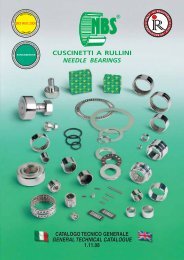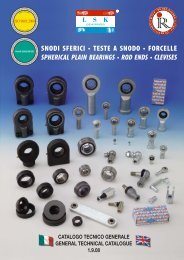ITC
ITC
ITC
Create successful ePaper yourself
Turn your PDF publications into a flip-book with our unique Google optimized e-Paper software.
V” = Velocità espressa in m/sec, è = 0,105 x R x n; oppure:<br />
( apple D n )<br />
60<br />
Rp= raggio primitivo della ruota di comando espressa in<br />
metri<br />
n = numeri di giri/minuto, della ruota comando<br />
p = peso in kg dei materiali che ogni tazza può contenere<br />
(considerandola piena) senza cioè tenere conto del<br />
calcolo del grado di riempimento “g”<br />
coefficienti di attrito radente:<br />
F = 0,33 fra metallo e metallo<br />
F1 = 0,59 fra metallo e carbone<br />
= 0,33 fra metallo ed antracite<br />
= 0,53 fra metallo e cenere (scorie umide)<br />
= 0,60 fra metallo e sabbie<br />
= 0,59 fra metallo e calcare<br />
= 0,33 fra metallo e grano<br />
coefficienti di attrito volvente:<br />
RF = X x d + 2y<br />
D D<br />
Dove:<br />
X = 0,33 fra metallo e metallo (non lubrificato)<br />
X = 0,20 fra metallo e metallo (lubrificato)<br />
D = diametro del rullo, espresso in mm.<br />
d = diametro del perno o della bussola intorno ai quali<br />
ruota il rullo (in mm.)<br />
y = mm. 0,75 fra metallo e metallo in condizioni medie<br />
Valori di C:<br />
Per elevatori verticali ........................ 0,15 ÷ 0,40 P<br />
Per trasportatori inclinati .................. 0,05 ÷ 0,15 P<br />
Per trasportatori orizzontali .............. 0,05 ÷ 0,10 P<br />
Tensione nelle catenarie<br />
Nel caso di un elevatore verticale a catene semplici, lo<br />
sforzo di tensione sarà uguale a quello rappresentato<br />
dallo sforzo motore P.<br />
Ovviamente, nel caso di catenaria doppia, lo sforzo di<br />
tensione, in ogni catena, corrisponderà alla metà di quanto<br />
sopra indicato.<br />
Nel caso di trasportatori orizzontali, lo sforzo di tensione<br />
sulle catene, sarà uguale allo sforzo di trazione nel caso<br />
della catena semplice, oppure corrisponderà alla metà<br />
dì tale sforzo, nel caso di catena doppia.<br />
Nel caso invece di trasportatori inclinati, si calcolerà lo<br />
sforzo della catena come somma degli sforzi prodotti dalla<br />
quota di peso del tratto portante e della quota dei peso<br />
trasportato, purchè l'inclinazione sia sufficiente affinchè<br />
il tratto di ritorno possa scendere per semplice gravità.<br />
Se detta inclinazione fosse insufficiente, ed il tratto di<br />
ritorno debba essere forzato a scendere dalla ruota, allora<br />
si dovrà tener conto anche di questo sforzo.<br />
Sforzo motore. Elevatori verticali<br />
1) P = (q + Q) x L<br />
<strong>ITC</strong><br />
10<br />
V” = speed expressed in m/sec is = 0,105 x R x n; or:<br />
( apple D n )<br />
60<br />
Rp = primitive radius of controlling wheel, expressed in mt<br />
n = number of revolutions per minute, of controlling wheel<br />
p = weight in kg of materials that every cup can contain<br />
(when full), without “g” degree of filling up<br />
coefficients of grazing friction:<br />
F = 0,33 between steel and steel<br />
F1 = 0,59 between steel and carbon<br />
= 0,33 between steel and anthracite<br />
= 0,53 between steel and ash (damp slags)<br />
= 0,60 between steel and sands<br />
= 0,59 between steel and limestone<br />
= 0,33 between steel and wheat<br />
coefficients of rolling friction:<br />
RF = X x d + 2y<br />
D D<br />
Where:<br />
X = 0,33 between steel and steel (not lubricated)<br />
X = 0,20 between steel and steel (lubricated)<br />
D = roller diam. expressed in mm<br />
d = diameter of pin or sleeve, around which rotates<br />
the roller (in mm)<br />
y = mm. 0,75 between steel and steel in medium<br />
conditions<br />
C values:<br />
For vertical elevators .........................0,15 ÷ 0,40 P<br />
For slanting conveyors ...................... 0,05 ÷ 0,15 P<br />
For horizontal conveyors ...................0,05 ÷ 0,10 P<br />
Strech in catenary<br />
In a vertical elevator with single strand chains, tension<br />
stress is equal to “P” stress engine. When the catenary<br />
is double, tension stress in every chain, is half of what<br />
above indicated. In orizontal conveyors, tension stress on<br />
chains is the same as the one of single strand chain or<br />
half of this stress if the chain is double.<br />
In sloping conveyors the stress is in this way calculated:<br />
the sum of stress producted from the weight of bearing<br />
section and from transported weight. The inclination has<br />
to be sufficient and the returning way has to go down by<br />
simple gravity.<br />
When this inclination is not enough and the returning<br />
section is forced to go down from the wheel, in this case<br />
we have to note this stress as well.<br />
Engine stress. Vertical elevators<br />
1) P = (q + Q) x L





